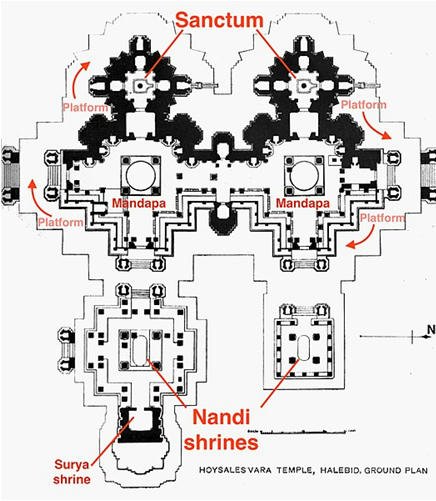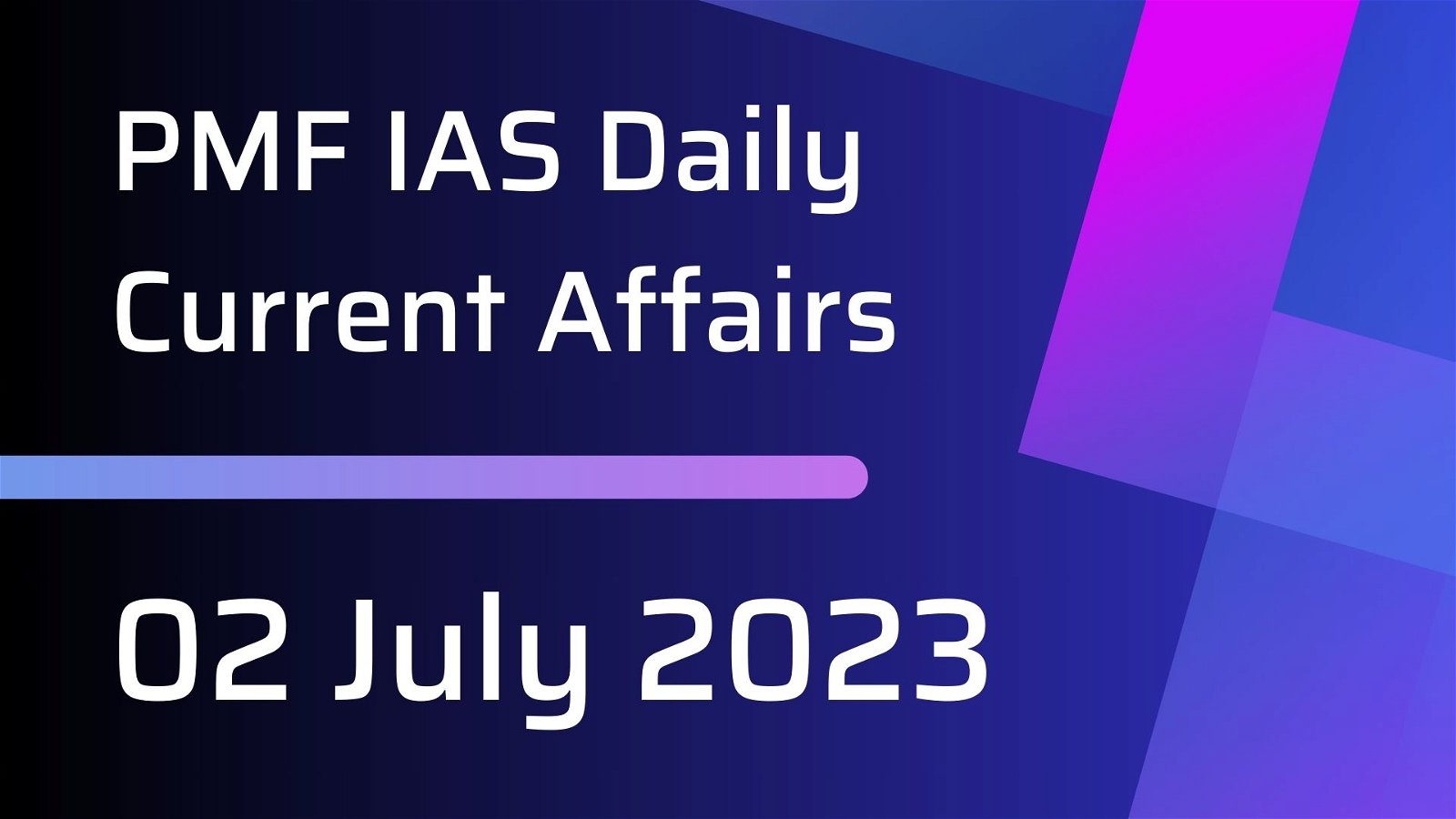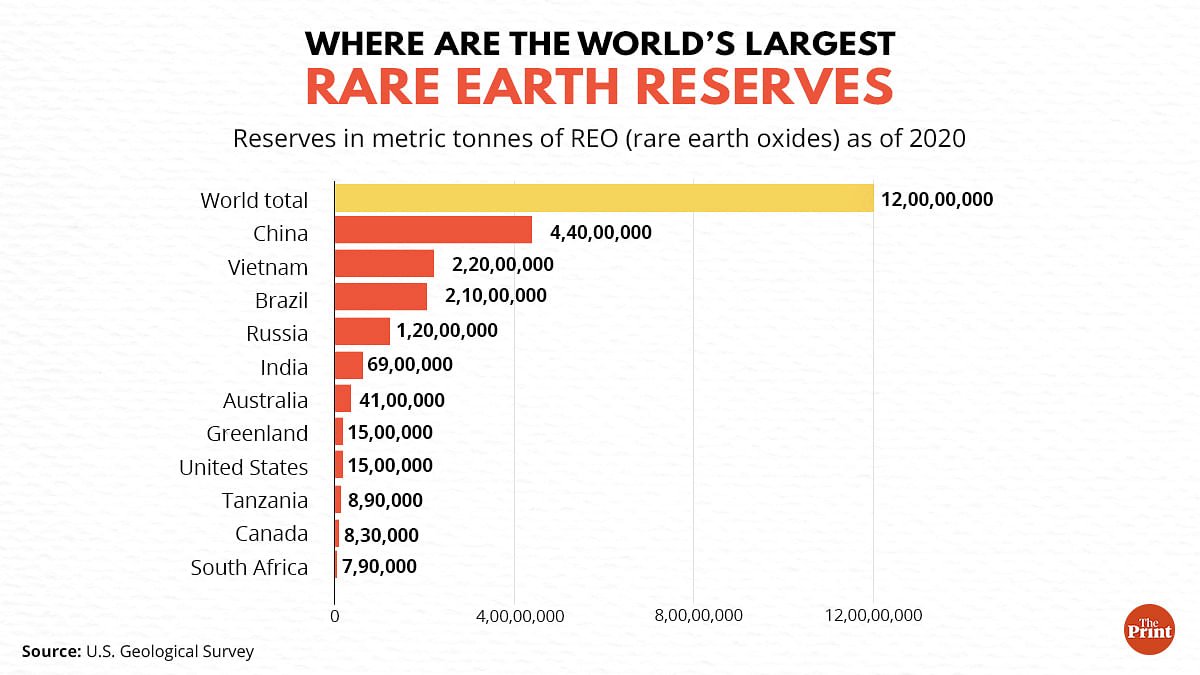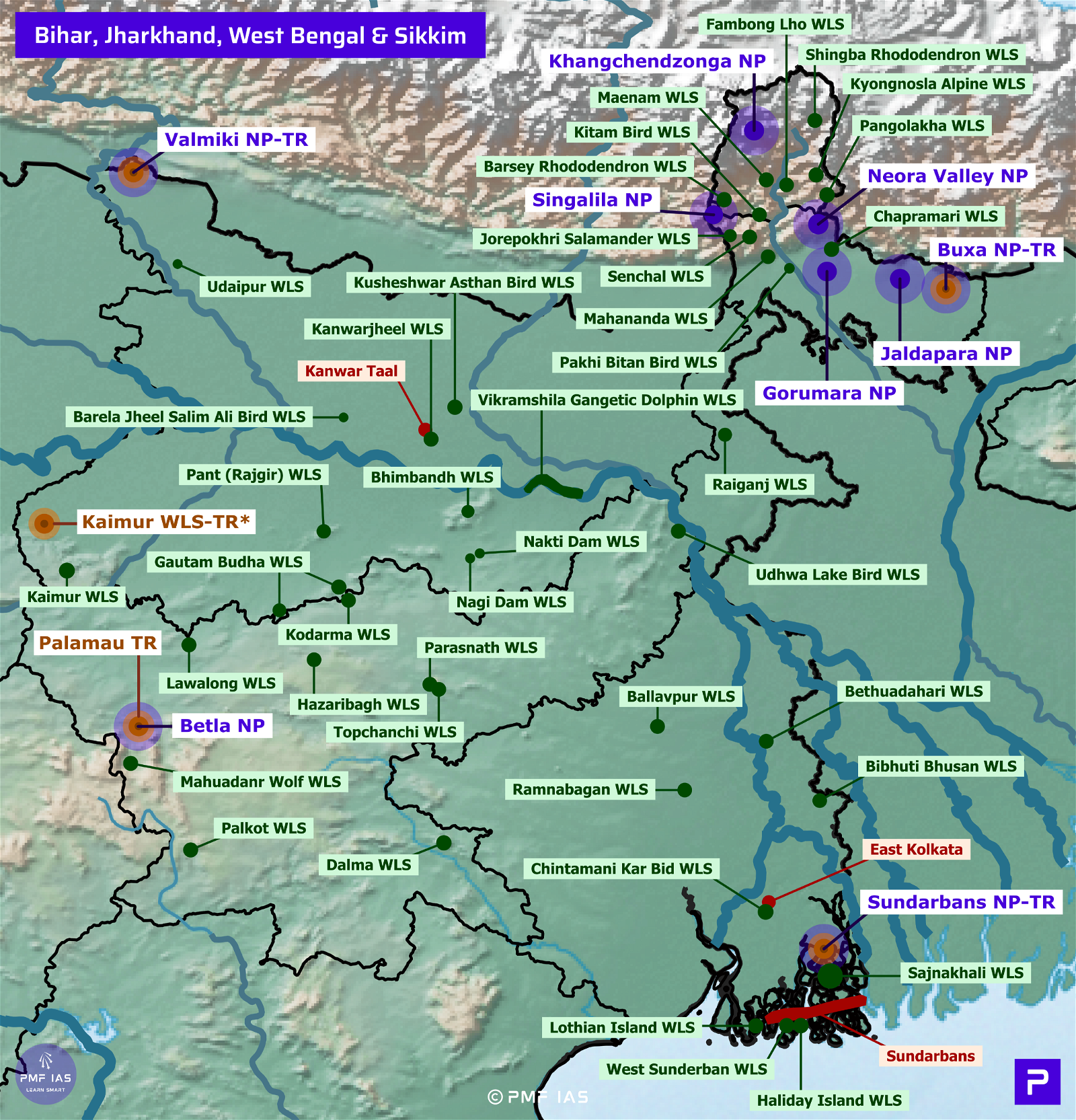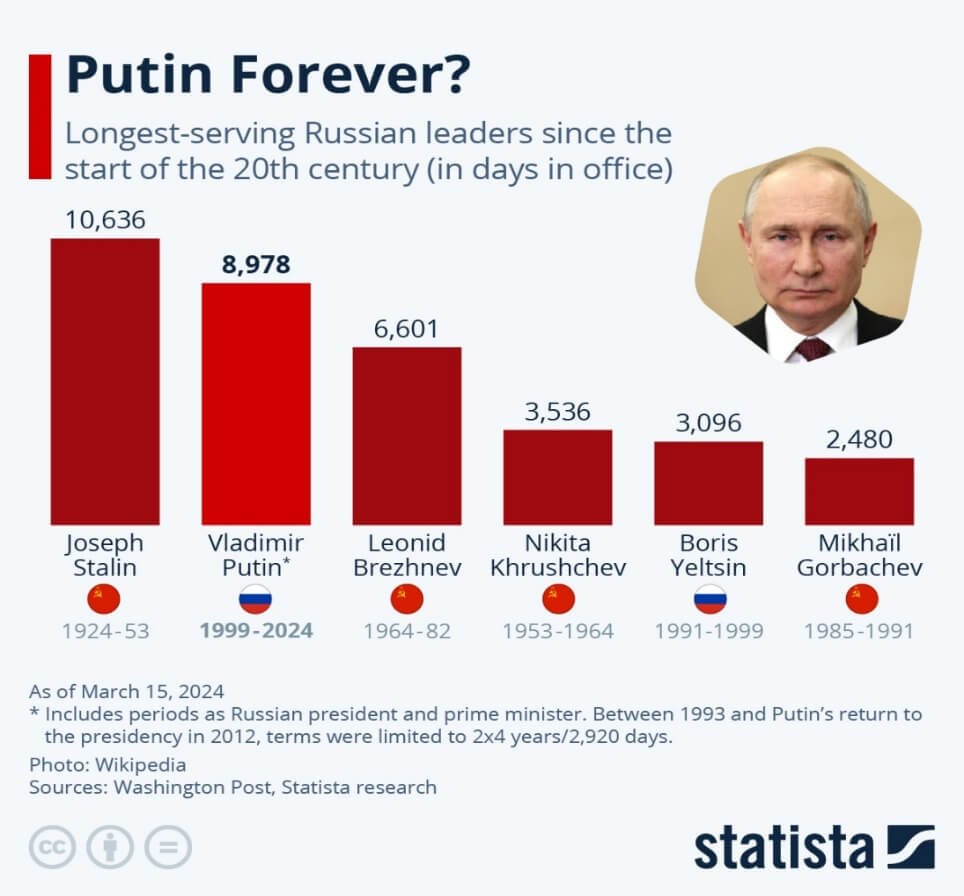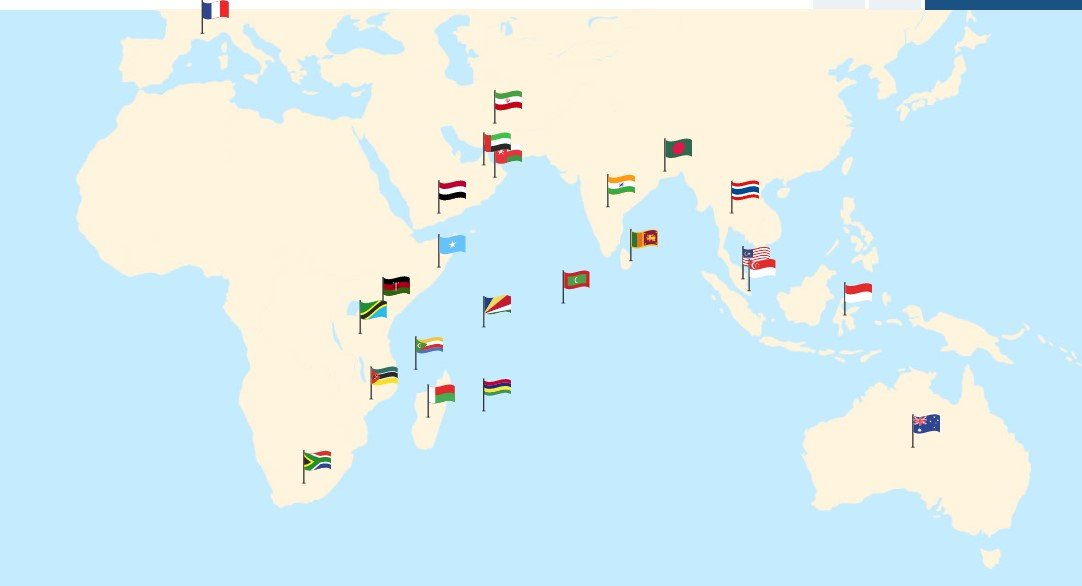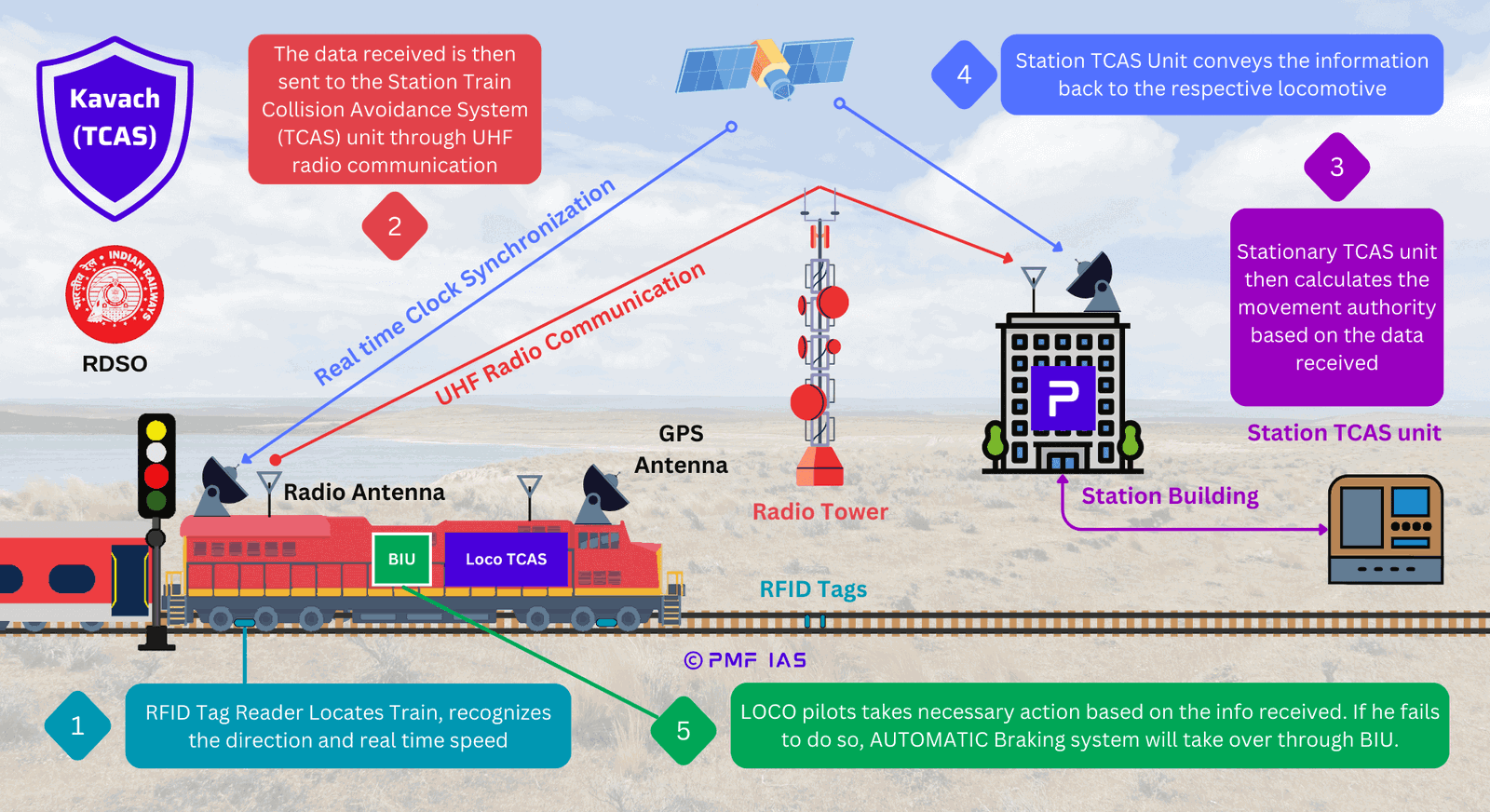
Current Affairs February 27, 2024: Vinayak Damodar Savarkar, Red Sea Crisis, Judicial Clarity on Free Speech, Mission Utkarsh, Bitcoin Halving, Ayutthaya: Venice of the East, Down Syndrome, Edwards Syndrome
Subscribers of "Current Affairs" course can Download Daily Current Affairs in PDF/DOC
Subscribe to Never Miss an Important Update! Assured Discounts on New Products!
Must Join PMF IAS Telegram Channel & PMF IAS History Telegram Channel
{GS1 – MIH – Personalities} Vinayak Damodar Savarkar
- Context (PIB): Prime Minister paid tributes to Veer Savarkar on his Punya Tithi.
- Vinayak Damodar Savarkar was born in 1883 in Bhagur village of Nashik, Maharashtra to father Damodarpant and mother Radhabai.
- He was educated at the local Shivaji High School and completed his bachelor’s degree from Fergusson College in Pune and went to England to study law at the Gray’s Inn Law College.
- He was regarded as a freedom fighter, politician, lawyer, social reformer, and the founder of the Hindutva philosophy.
- He was given the title of ‘Veer’ as he was a courageous person who fought for his ideologies.
- He was the first to acknowledge the mutiny of 1857 as the first struggle for Independence.
- He founded the two-nation theory in his book ‘Hindutva’ calling Hindus and Muslims two separate nations. In 1937, Hindu Mahasabha passed it as a resolution.
- In 1948, he was charged as a co-conspirator in the assassination of the Father of Nation, Mahatma Gandhi, but was later acquitted by the court due to lack of evidence.
- He died on 26 February 1966, at the age of 83.
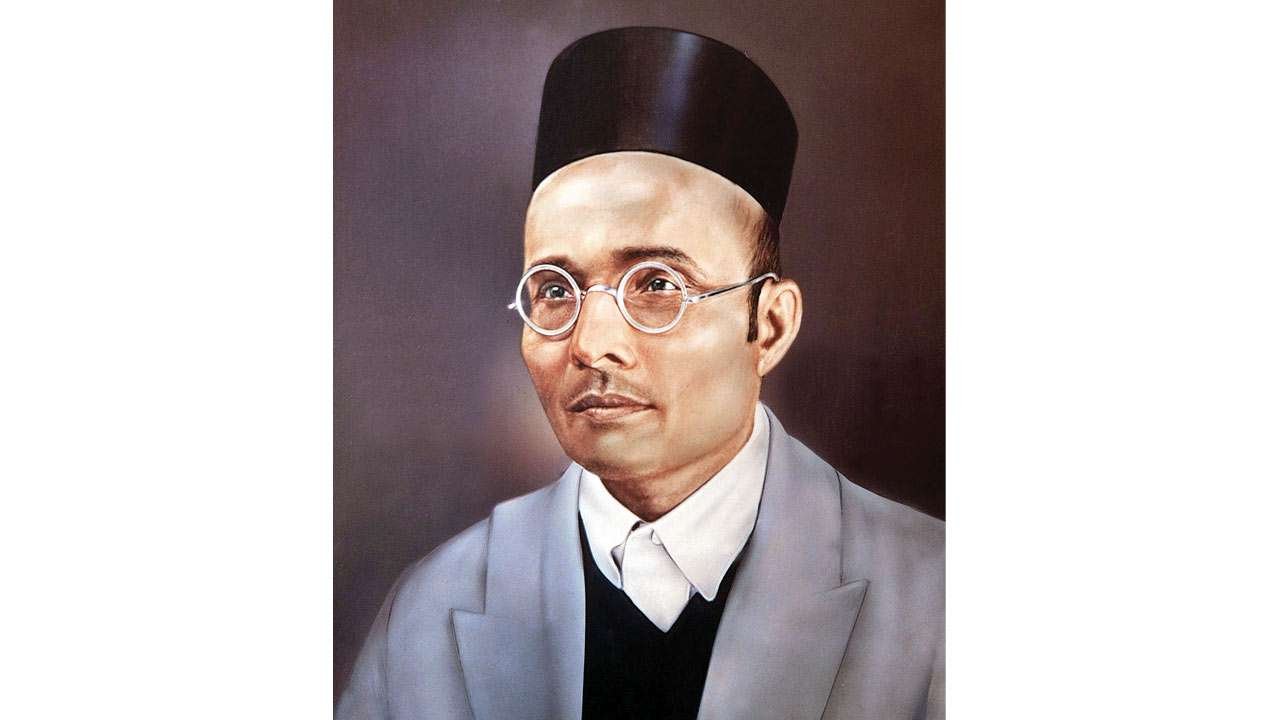
Contribution to National Movement
- According to Savarkar, the liberation of the Motherland was to be achieved by a preparation for war which included the teaching of Swadeshi, boycott of foreign goods; imparting national education, creating a revolutionary spirit; & carrying patriotism into military forces.
- As a young man, he was inspired by Bal Gangadhar Tilak, Bipin Chandra Pal and Lala Lajpat Rai.
- Earlier in 1899, when he was just 16 year’s old, Savarkar formed Mitra Mela, a group whose principal aim was to attain the complete political independence of India.
- The name of the group was later changed to Abhinava Bharat. It had a close resemblance to ‘Young Italy’ movement of Guiseppe Mazzini & that of revolutionary societies in Russia.
- He founded the Free India Society, in London, in 1906, based on the thoughts of the Italian nationalist Giuseppe Mazzini (Savarkar had written a biography of Mazzini).
- He was also a member of India House (founded by Shyamji Kishan Verma in 1905 in London).
- In early May 1907, Savarkar organized the celebration of the 50th anniversary of the Indian Rebellion of 1857 at Tilak House, London.
- He allegedly prepared handmade bombs for guerrilla warfare.
- He provided legal defence to his friend Madan Lal Dhingra, who was accused in a murder case of a British Indian army officer.
- In 1909, he was arrested on charges of plotting an armed revolt against the Morley-Minto reform (Indian Councils Act 1909). He tried to escape but was arrested.
- He arrived in the Andaman Islands in July 1911 where he stayed until 1921, when he was moved to Ratnagiri, Bombay Presidency, where he was imprisoned until 1924 and interned until 1937.
- After 1937, Savarkar continued his anti-Muslim, anti-British politics and President of the right-wing Hindu Mahasabha (he was not its founder).
- He was a strong critic of Mahatma Gandhi and the Indian National Congress.
- He opposed the Quit India struggle in 1942.
Savarkar’s Dream State
- His vision of India was one in which all citizens would have equal rights and obligations irrespective of caste, creed, race or religion, provided they avow and owe an exclusive and devoted allegiance to the State.
- All minorities were to be given effective safeguards to protect their language, religion, culture, etc. but none of them would be allowed to create a State within a State or to encroach upon the legitimate rights of the majority.
- Fundamental rights of freedom of speech, freedom of conscience, of worship, of association, etc. were to be enjoyed by all citizens alike.
- There would be joint electorates and ‘one man one vote‘ would be the general rule.
- He waged a war against casteism and untouchability and fervently wrote against the taboos regarding inter-caste marriages, sea-crossing and re-conversion.
Literary Contributions
- During his imprisonment, he wrote the book ‘Hindutva: Who Is a Hindu? (1923)’, coining the term Hindutva, which later defined the Hindu nationalist ideology.
- On the lines of the ‘Revolt of 1857’, he wrote a book titled “The History of the War of Indian Independence” which was banned by the British.
- He wrote Hindutva in Ratnagiri jail under his pen-name Mahratta.
Abhinav Bharat (Young India Society)
|
{GS2 – IR – Middle East} Red Sea Crisis
- Context (TH): As the Red Sea crisis enters its fourth month, global supply chains are increasingly grappling with inflated freights, delayed vessel schedules, and product shortages.
- It has brought to the fore the vulnerabilities of global supply chains, highlighting the need to revisit alternate routes for global trade.
Importance of Red Sea Route

- The Red Sea can be accessed via two “choke points”: Suez Canal from the north and Bab-el-Mandeb Strait in the south. Both are narrow passages of water that large container ships must pass through.
- About 12% of global trade and 30% of global container traffic traverses the Suez Canal – and by extension the Red Sea – transporting more than $US1 trillion worth of goods each year.
- In 2023, about 10% of the world’s seaborne oil trade and 8% of global LNG trade passed through the canal.
- It is also an important route for oil and natural gas sent to North America from the Persian Gulf.
- It is also strategically important to Russia, which uses the canal to export oil to India and China.
- The canal is also financially important to Egypt. Revenues from tolls that ships have to pay to transit through the canal rose to a record $US7 billion in 2021-22.
Impact of Red Sea Crisis on International freight movement
- The Suez Canal, responsible for handling 12-15% of global trade in 2023, saw an 82% drop in container tonnage in the first half of February this year.
- Major container and oil carriers have been forced to re-route shipments via the Cape of Good Hope with tonnage around the Cape of Good Hope experiencing an increase by 60%.
- The disruption coincides with Panama Canal facing reduced transits due to drought, highlighting vulnerabilities in global trade routes.
- The re-routing has led to rising ocean freight, inflated insurance costs, and longer voyage times leading to delays and shortage of products.
- It has also driven up transportation costs. The higher shipping costs will be passed onto consumers in the form of increased commodity prices.
- Instability in the Red Sea causes increased fuel costs, an additional $1 million in fuel for every round trip between the Far East and North Europe, and war risk surcharge.
- Oil prices rose more than a dollar a barrel after the Houthi attacks.
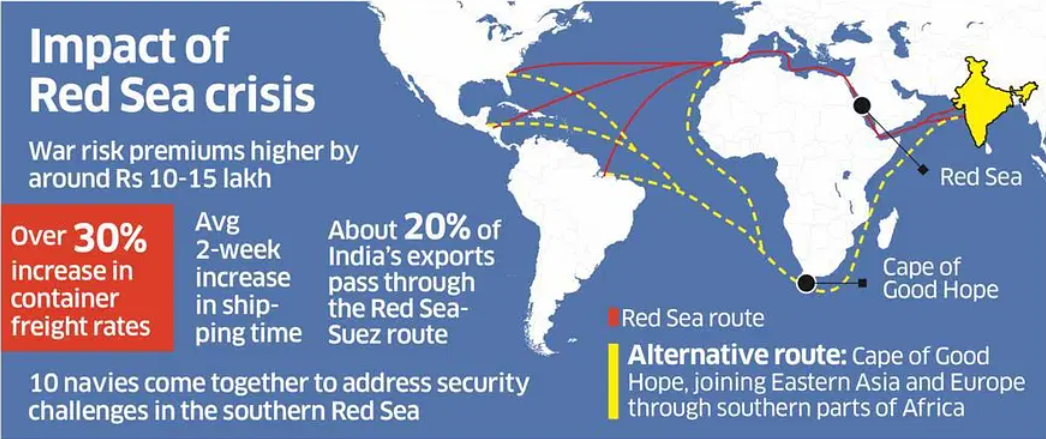
Impact on India
- The Red Sea route is shorter and faster, making it the preferred option for most shipping companies.
- India’s trade with European and North African countries flows entirely through the Red Sea route which is almost 24% of its exports and 14% of its imports.
- In 2022-23, India’s bilateral trade with Europe and North Africa stood at $189 billion and $15 billion respectively. The rising fears among traders have already seen a drop in Indian shipments.
- As per the Federation of Indian Export Organisations (FIEO), rising threats have prompted Indian exporters to hold back around 25% of their cargo ships transitioning through the Red Sea.
Can IMEC address the Red Sea Crisis?
What is IMEC?
- India-Middle East-Europe Economic Corridor (IMEC) is a proposed economic corridor to enhance connectivity and economic integration among Asia, the Middle East, and Europe.
- It will span from India to Europe through India, UAE, Saudi Arabia, Jordan, Israel, and Greece.
- It will include railway lines, shipping lanes, and road networks.
- Indian ports that will be connected to IMEC: Mundra (Gujarat), Kandla or Deendayal Port (Gujarat), and Jawaharlal Nehru Port Trust (Navi Mumbai).
- It is a counter to China’s Belt and Road Initiative (BRI), which aims to connect China to Europe and Africa.
- The corridor is estimated to cut the journey time from India to Europe by 40% and slash transit costs by 30%.

Significance of IMEC
- India: It will secure access to European trade routes, allowing India to be better equipped to formulate stronger strategies at both national policy and individual business levels.
- Additionally, it would diversify India’s accessible trade routes, further safeguarding it against concentration risk.
- Enhanced security and diversification will attract more interest from investors and further develop its economy.
- Europe: The proposed corridor will provide access to the Indian market and further facilitate its growth.
- GCC and other nations along the corridor will experience a boost in transport-related revenues, including income from port fees and railway transportation services.
What has been ailing the IMEC?
- Apart from the MoUs, there have not been any investments or operations regarding the corridor.
- Israel-Palestine conflict halting the normalisation of Arab-Israel relations further hampering the multi-nation initiative.
- Vulnerability of the Strait of Hormuz. The entire trade of the IMEC architecture flows through the Strait and with Iran’s proximity and control over the strait, the risk of disruptions remains high.
- IMEC also excludes some countries that, geographically, seem like prime candidates for inclusion, such as Iraq, Oman and Turkiye.
How can the IMEC be made viable?
- Encouraging the involvement of locally based infrastructure developers, transportation and logistics operators should be explored to preserve long-term value for the participating countries.
- Strong political alignment and commitment is critical to successful delivery.
- Developing a clear quantitative business case for the development of the corridor.
- Establishing a clear and agreeable commercial structure.
{GS2 – MoWCD – Initiatives} Mission Utkarsh
- Context (TH): The Ministry of Ayush and the Ministry of Women and Child Development have signed a MoU for the nutritional improvement in adolescent girls under Mission Utkarsh.
- Mission Utkarsh aims to control Anaemia among adolescent girls using Ayurvedic interventions.
- Initially, the initiative will be launched in five aspirational districts across five states as a pilot project.
- The program aims to transform the most underdeveloped districts of the country by focusing on improving their socio-economic indicators.
- 15 central ministries or departments will work together to elevate districts from the bottom to state and national averages.
- The aim is nutritional improvement among approximately 95,000 adolescent girls in anaemia-prone districts.
Anaemia
- Anaemia is a common blood disorder characterised by a reduction in the number of red blood cells (RBCs) or a decrease in the amount of haemoglobin (the protein that carries oxygen) in the blood.
- Causes:
- Iron Deficiency: Iron is essential for RBC production.
- Vitamin Deficiencies: Lack of vitamin B12 or folate can also lead to Anaemia.
- Chronic Diseases: Certain chronic conditions (e.g., kidney disease, inflammatory disorders) affect RBC production.
- Blood Loss: Excessive bleeding (due to menstruation, injury, or gastrointestinal issues) reduces RBCs.
- Inherited Disorders: Some genetic conditions affect RBC structure or production.
- Symptoms: Fatigue, Pale Skin, Shortness of Breath, Dizziness and Headaches, Cold Hands and Feet, Brittle Nails and Hair.
- Impact on Health: Reduced Physical Performance, Poor concentration, memory issues, and irritability.
- Complications: Severe Anaemia can lead to heart problems, organ damage, and even death.
Treatment and Prevention
- Iron Supplements: For iron-deficiency Anaemia.
- Dietary Changes: Consuming iron-rich foods (leafy greens, red meat, legumes).
- Vitamin Supplements: Addressing deficiencies.
- Blood Transfusions in severe cases.
India’s anaemia burden
- According to NFHS-5 (2019-21) finding that 57% of women in the age group 15-49 and 67% of children between six months and 59 months are anaemic (from the corresponding 53% and 58.6% respectively in NFHS-4 (2015-16)).
{GS2 – Polity – IC – FRs} Judicial Clarity on Free Speech
- Context (TH I IE): Bombay HC’s decision on Kunal Kamra’s case upholds the constitutional right to free speech, particularly in the realm of social media.
- The decision highlights the inherent dangers of arbitrary censorship and the need for clear, reasonable restrictions in line with constitutional principles.
Concerns Raised by the High Court
- The amended Rules, though well-intentioned, lack necessary safeguards.
- The rules do not offer protection to fair criticism of the government, like parody and satire.
- Ambiguity surrounding the term “any business of the Central government,” could include speeches made ahead of the 2024 Lok Sabha elections within its ambit.
- Why the Rules would exclusively affect digital media and not its print counterparts?
- Why was the monitoring only limited to government business and not to every piece of information available on the internet?
HC’s Observations
Upholding Free Speech
- The constitutional guarantee of free speech shall not be tinkered with or read down, except for the reasonable restrictions under Article 19(2), (6) of the IC.
Rejection of Arbitrary Censorship
- The amended Rule 3(1)(b) of the IT Rules 2021 is vague and poses a threat to critical discourse and debate.
Constitutional Principles
- The amended rule violates fundamental rights and lacks reasonable standards.
- This assessment drew upon various principles, including the doctrine of proportionality.
- The HC held that the amendments are:
- A form of censorship of user content that is vague and overbroad,
- Destructive of the right to criticise and debate,
- It fails to provide reasonable standards for assessing the validity of decisions made by the FCU, which functions as the sole decision-maker.
- Not within the boundaries of reasonable restrictions in Articles 19 (2)(6).
- Violative of the principles of non-arbitrariness and non-discrimination outlined in Article 14.
- It lacks clear guidance and fails to apply equally to the print media.
Significance of the Judgement
Fake news and regulation of Digital Media
- It acknowledges the need to combat misinformation and insists on the importance of balanced regulation that respects free speech rights.
- Fakery and misinformation are not only a threat to democracy but also to the indefeasible right to the reputation and dignity of individuals.
Balancing the FRs and Unreasonable Restrictions
- It represents a just balance between ‘the abyss of unrestrained power’ and the ‘heaven of freedom.’
Judicial review
- It validates the logic of judicial review as a bulwark against the excesses of government entities and untamed power.
Upholds Democratic Values
- It reaffirms the fundamentals of a democratic State that “the will of the State is subject to scrutiny by those who are affected by the exercise of State power and that democratic power”.
- In times of executive-centred governance, a law that permits its enforcers to become agents of injustice cannot be countenanced in a constitutional democracy.
Central Government’s Argument
- The FCU will only notify intermediaries that the content they are hosting is fake, false, or misleading, and the intermediaries can choose to take it down or leave it up with a disclaimer.
- FCU’s notice is merely advisory; the GOI submitted that in case the intermediary’s decision aggrieves a user, they can avail of a remedy before a court of law, the final arbiter on the matter.
Background
- The IT Act of 2000 was amended in 2008 to provide an exemption to intermediaries from liability for any third-party information.
- Following this, the IT (Intermediary Guidelines) Rules, 2011, were framed under the IT Act to specify the due diligence requirements for intermediaries to claim such exemption.
- IT (Intermediary Guidelines and Digital Media Ethics Code) Rules, 2021 were notified to replace the 2011 Rules.
- In 2023 amendments to 2021 rules were introduced.
- Number of petitions were filed challenging the constitutionality of the IT Amendment Rules, 2023.
What are the IT Rules?
- The IT Rules derive their authority from the Information Technology Act of 2000, which provides legal recognition for electronic commerce.
Safe Harbour Provision
- The Act provides a “safe harbour” for intermediaries that observe due diligence in discharging their duties and follow guidelines prescribed by the state.
Intermediaries
- Section 79 of the Act grants immunity to intermediaries as long as they follow due diligence and state-prescribed guidelines.
- Intermediaries include social media platforms like WhatsApp, Twitter, Facebook, and Instagram.
2021 Regulations
- The 2021 IT Rules replaced the previous guidelines and sought to regulate intermediaries and digital news media.
First Originator
- Social media platforms were required to provide technological solutions to identify the first originator of any information, risking privacy.
Establish a Grievance Officer
- The intermediaries are required to establish a grievance redressal mechanism and remove unlawful and unfitting content within stipulated time frames.
- The grievance officer is responsible for receiving and resolving the complaints of the users.
Ensuring online Safety and Dignity of Users
- Intermediaries shall remove or disable access within 24 hours of receipt of complaints of contents
- That expose the private areas of individuals,
- Show such individuals in full or partial nudity or
- A sexual act or is in the nature of impersonation, including morphed images, etc.
Mandates Social Media to Exercise Greater Diligence
- Broadly, the IT Rules (2021) mandate social media platforms to exercise greater diligence with respect to the content on their platforms.
IT Amendment Rules, 2023
- The GoI can decide what information is false and enforce extensive censorship by compelling intermediaries to remove such content.
- Freedom of speech can be restricted through executive order rather than legislation.
- The proposed amendment also includes online gaming within its ambit.
New Guidelines for Social Media Intermediaries
- These impose a legal obligation on intermediaries to make reasonable efforts to prevent users from uploading such content.
- The new provision ensures that the intermediary’s obligation is not a mere formality.
- The intermediaries have to respect the rights guaranteed to users under Articles 14, 19 and 21 of the IC, therefore including a reasonable expectation of due diligence, privacy and transparency.
- For effective communication of the intermediary’s rules and regulations, the communication must be done in regional Indian languages as well.
Amendments to the Rule 3
- The grounds in sub clause 1 of rule 3 (rule 3(1) (b) (ii)) have been rationalised by removing the words ‘defamatory’ and ‘libellous’.
- Whether any content is defamatory or libellous will be determined through judicial review.
- Some of the content categories have been rephrased to deal with misinformation that could incite violence between different religious/caste groups.
Section Rule 3(1)(b)(v)
- The intermediary shall make reasonable efforts to ensure that the users of its computer resource do not host, display, modify, publish, store or share any information related with respect to any business of the GoI and identified as fake by the fact-checking unit of the GOI.
- Where an intermediary fails to observe these rules, the intermediary shall be liable for punishment under any law for the time being in force, including the provisions of the Act and the IPC.”
Establishment of Grievance Appellate Committee(s)
- Grievance Appellate Committee(s) will be established to allow users to appeal against the inaction of, or decisions taken by intermediaries on user complaints.
- However, users will always have the right to approach courts for any remedy.
Fact Check Unit (FCU)
- FCU to control the digital content in matters connected with the business of the GoI.
- FCU will be under the Ministry of Electronics and Information Technology (MeitY).
- Safe harbour protection: The intermediaries will have to take down the content labelled as fake by the FCU or lose their legal immunity against third-party content online.
- The FCU has limitless powers to decide what information is false and compel social media intermediaries to act based on these findings, which are open-ended and undefined.
- Information marked as “fake or misleading” by PIB’s fact-check unit, or any agency “authorised by the GOI for fact-checking” would need to be taken down.
|
FCU & the Freedom of Speech Debate
- The amendment does not define the term ‘any business of the Central government.’
- Intermediaries are likely to protect their commercial interests rather than risk losing safe-harbour protection for non-compliance with the directions of the FCU.
Issues related to 2023 Amended Rules
Lacks Clear Definitions
- It fails to define fake news and allows the FCU to declare any news “in respect of any business” that involves the state.
- The use of undefined words, like “any business“, gives the GOI unchecked power to decide what people can see, hear, and read on the internet.
Not a Standard Practice
- A comprehensive parliamentary legislation on fake news, would have been a more constitutionally committed campaign against fake news.
- In France, an independent judge is responsible for making declarations to counter the spread of misinformation during elections.
- An enacted statute would have required exploring less strict options before removing misinformation.
Removable of Information
- Intermediaries will remove information deemed false by the FCU, leaving only the state to determine what is true.
Lesser Rights
- The rights of the press and individuals to question authority and speak truth to power will be diminished, and civil liberties will be curtailed.
Violates the Supreme Court’s Judgment
- Shreya Singhal vs Union of India (2015), Supreme Court held that a law that limits speech can neither be vague nor over-broad.
{GS3 – S&T – AI} Bitcoin Halving
- Context (TH): Bitcoin Halving is to happen in April.
What is Bitcoin Halving?
- A Bitcoin halving occurs approximately every four years.
- It is an event where the reward for mining Bitcoin transactions is cut in half.
- In other words, the number of new bitcoins created and awarded to miners is reduced by 50%.
- The halving is hard-coded into Bitcoin’s protocol and is a fundamental part of its monetary policy.
Why Does Bitcoin Halving Happen?
- The halving policy was designed to counteract inflation and maintain scarcity.
- By reducing the rate at which new coins are created, Bitcoin becomes scarcer over time.
How Does It Work?
- Bitcoin operates on a system called proof-of-work (PoW).
- Miners use computational power to validate transactions and secure the network.
- When a miner successfully adds a new block of transactions to the blockchain, they are rewarded with bitcoins.
- Before the first halving, miners received 50 BTC per block. After the halving, it became 25 BTC per block.
- The most recent halving occurred on May 11, 2020, reducing the reward to 6.25 BTC per block.
- The next halving is expected in early to mid-2024, further reducing the reward to 3.125 BTC per block.
Impact on the Crypto Community
- Supply Reduction: Halvings reduce the rate at which new bitcoins are introduced into circulation. This scarcity could drive up the price due to increased demand.
- Market Sentiment: Halvings often create bullish sentiment in the crypto community. Traders and investors anticipate price increases.
- Long-Term Investment: Some see halvings as a signal to accumulate Bitcoin for the long term.
- Mining Economics: Miners’ revenue decreases after halving, which may impact their operations and profitability.
- Historical Trends: Previous halvings have been followed by significant price rallies.
Final Halving and Maximum Supply
- The final halving is expected around the year 2140.
- By then, the total number of bitcoins in circulation will reach the theoretical maximum supply of 21 million.
- This fixed supply makes Bitcoin a deflationary asset (digital or virtual currency designed to decrease in supply over time, leading to an increase in its value).
To know more about Cryptocurrencies, refer to PMF IAS CA July 2023.
{GS3 – S&T – Space} Space Infrastructure Projects
- Context (TH | PIB): PM inaugurated 3 major space infrastructure projects developed by the Indian Space Research Organisation at Vikram Sarabhai Space Centre (VSSC) in Thiruvananthapuram.
- These projects aim to enhance India’s capabilities in the field of space exploration.
Trisonic Wind Tunnel at VSSC
- This facility produces controlled, uniform airflow over scaled models of rockets and aircraft.
- It evaluates their aerodynamic characteristics and designs.
- It features a test section size of 1.2 meters and can generate speeds ranging from subsonic to supersonic (up to 4 times the speed of sound).
Semi-Cryogenic Integrated Engine and Stage Test Facility
- Located at ISRO’s propulsion complex in Mahendragiri, Tamil Nadu.
- It will enable the development of semi-cryogenic engines and stages, which will increase the payload capability of the present launch vehicles.
- The facility is equipped with liquid oxygen and kerosene supply systems to test engines with up to 200 tons of thrust.
PSLV Integration Facility
- Developed at the Satish Dhawan Space Centre (SHAR) in Sriharikota, Andhra Pradesh.
- Includes Integration Building, Service Building, Rail Track, and associated systems.
- It will help in boosting the frequency of PSLV launches from 6 to 15 per year.
- It can cater to the launches of SSLV and other small launch vehicles designed by private space companies.
{Prelims – In News} Ayutthaya: Venice of the East
- Context (PIB): Bihar Governor’s visit to the Ancient City of Ayutthaya in Thailand.

- Ayutthaya is named after the birth city of Lord Ram in Ayodhya, India.
- The Historic City was founded in 1350. It was the 2nd capital of the Siamese Kingdom after Sukhothai.
- It flourished from the 14th to the 18th centuries, during which it grew to be one of the world’s largest and most cosmopolitan urban areas and a centre of global diplomacy and commerce.
- Ayutthaya was strategically located on an island surrounded by three rivers connecting the city to the sea.
- This site was chosen because it was located above the tidal bore of the Gulf of Siam as it existed at that time, thus preventing attack on the city by the sea-going warships of other nations.
- The city was attacked and razed by the Burmese army in 1767, who burned the town to the ground and forced the inhabitants to abandon the city.
- The city was never rebuilt in the exact location and remains known today as an extensive archaeological site.
- Ayutthaya was laid out according to a systematic and rigid city planning grid consisting of roads, canals, and moats around all the principal structures.
- The city had a hydraulic system for water management, which was technologically highly advanced and unique in the world.
- Ayutthaya is now an archaeological ruin, characterized by the remains of tall prang (reliquary towers) and Buddhist monasteries of monumental proportions.
{Prelims – In News} Homosep Atom: India’s 1st Septic Tank Cleaning Robot
- Context (PIB): India’s first septic tank/manhole cleaning robot, Homosep Atom, is offering an end-to-end solution to eliminate manual scavenging.
- Homosep Atom is developed by a startup incubated in the Department of Science and Technology (DST)-Technology Business Incubator (TBI) of IIT Madras.
- The Homosep Atom performs blade cleaning, solid waste desilting, suction, and storage all in one device reducing the need for owning multiple assets and promotes robotic cleaning in sewers.
- The robot empowers sanitary workers by allowing them to clean manholes from outside, avoiding exposure to toxic environments.
- Solinas also developed India’s first 90mm water robot and 120mm sewer robot, addressing contamination challenges in water-sewer pipelines.
{Prelims – Sci – Bio – Diseases} Down Syndrome | Edwards Syndrome
- Context (TH): Researchers have reported chromosomal disorders in prehistoric skeletal remains dating back up to 5,500 years.
- The research marks the 1st identification of Edwards syndrome from historic or prehistoric remains.
- The findings date back to the Bronze Age (around 2,700 BCE) and the Neolithic period (around 3,500 BCE).
Down syndrome
- Down syndrome is named after the physician Langdon Down, who first observed this condition.
- It is due to the presence of an extra chromosome 21, also known as trisomy of chromosome 21.
- This extra copy changes how a baby’s body and brain develop. It can cause both abnormal mental and physical development during their lifetime.
- Down syndrome is also due to the translocation of a part of a chromosome to another chromosome.
- It is one of the leading causes of genetic disorders around the world. It is mostly not inherited.
- It is a chromosomal disorder caused by abnormal cell division.
- It is due to aneuploidy of the autosome (any chromosome that is not a sex chromosome).
|
- There is no cure; only the quality of life can be improved by taking extra care.

- The occurrence of Down syndrome is 1:800 live births.
- The primary risk factor is the age of the mother. Most trisomy cases occur in mothers aged more than 35.
Edwards syndrome
- It is named after Dr. John H. Edwards, who first described the condition in 1960.
- Also known as Trisomy 18, it is a chromosomal disorder caused by the presence of an extra copy of chromosome 18.

- Edwards syndrome is a rare congenital disorder that affects approximately 1 in every 5,000 live births.
- There is no cure for Edwards syndrome, and treatment focuses on managing the individual symptoms and providing supportive care.
- Symptoms: Low birth weight, small head, intellectual disability and developmental delays, Facial abnormalities, etc.
Types of Trisomy 18
- Full/Complete Trisomy 18: This is the most common form of Edwards syndrome, where every cell in the body contains three copies of chromosome 18.
- Mosaic Trisomy 18: In this form, some cells have the extra chromosome 18, while others have the normal pair.
- Mosaic Trisomy 18 often leads to milder symptoms compared to full Trisomy 18.
- Partial Trisomy 18: This occurs when only a portion of chromosome 18 is duplicated instead of the entire chromosome.
- Partial Trisomy 18 is the least common form and often results from specific genetic abnormalities.





![PMF IAS Environment for UPSC 2022-23 [paperback] PMF IAS [Nov 30, 2021]…](https://pmfias.b-cdn.net/wp-content/uploads/2024/04/pmfiasenvironmentforupsc2022-23paperbackpmfiasnov302021.jpg)

